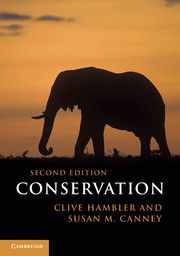Book contents
- Frontmatter
- Contents
- Preface to the Second Edition
- 1 Introduction to conservation
- 2 Threats to biodiversity
- 3 Evaluation of priorities for species and habitats
- 4 Monitoring and Environmental Impact Assessment
- 5 Management of natural and fragmented habitats
- 6 Management of species
- 7 Sustainable use, semi-natural cultural landscapes and the matrix
- 8 Restoration and offsetting
- 9 Environmental policy
- References
- Index to species names
- Index
- Plate section
5 - Management of natural and fragmented habitats
Published online by Cambridge University Press: 05 February 2013
- Frontmatter
- Contents
- Preface to the Second Edition
- 1 Introduction to conservation
- 2 Threats to biodiversity
- 3 Evaluation of priorities for species and habitats
- 4 Monitoring and Environmental Impact Assessment
- 5 Management of natural and fragmented habitats
- 6 Management of species
- 7 Sustainable use, semi-natural cultural landscapes and the matrix
- 8 Restoration and offsetting
- 9 Environmental policy
- References
- Index to species names
- Index
- Plate section
Summary
This chapter outlines the general features of management of natural systems and habitat fragments. Management is required to maintain the features of interest of an area, which have been identified by the methods in Chapter 3. Any protected area can require management and we give examples for major biomes of the world. We then consider the effectiveness of protected areas as these are the key tool for the management of natural systems. The ideal management of reserves for wildlife protection will inevitably affect people in and near reserves, requiring their integration into the management plan and compensation for loss of resources. These socio-political aspects of governance and equity are discussed in Chapter 9.
For strict nature reserves, management aims to protect naturalness against threats to the species and to the integrity of the habitats in the reserve. Threats to highly natural sites often come from outside the site. We should be careful not to ‘overmanage’ sites – and so do more harm than the threats that we are trying to prevent. Overmanagement is a risk when we know little about the natural processes of a site. It is also a waste of effort.
Naturalness may be defined as the lack of human influence or as how little the habitat would change if there were no people there. A reason for detaching people from ‘Nature’ through such definitions is that our species, through capacities of self-awareness and prediction, has developed technologies that give us unprecedented power to overexploit the biosphere. Fortunately, these capacities also provide the tools to mitigate our impact. The reality is that we are inextricably embedded in the natural world and are subject to its laws, as any other species. Yet imagining – however unrealistically – that we are not part of an ecosystem is the only way we can identify our impact on it.
- Type
- Chapter
- Information
- Conservation , pp. 161 - 202Publisher: Cambridge University PressPrint publication year: 2013



